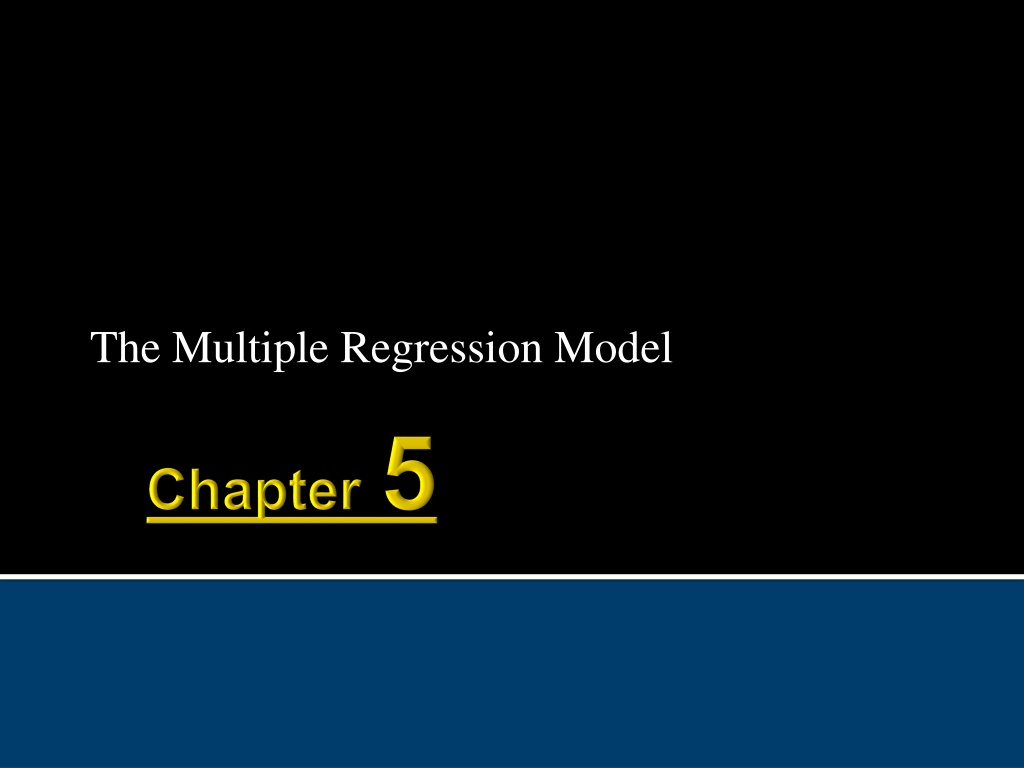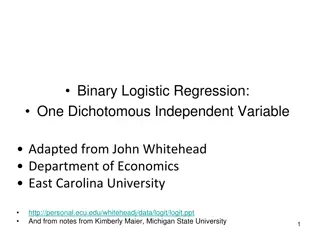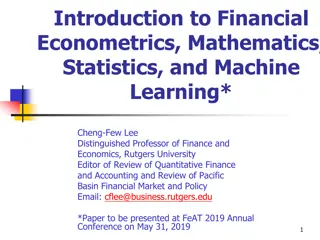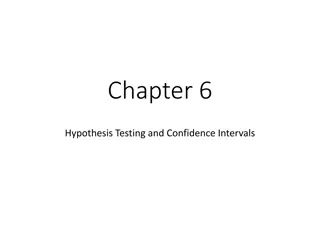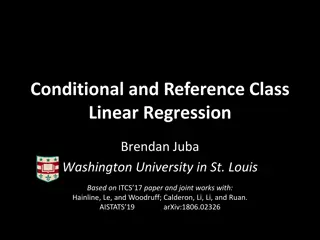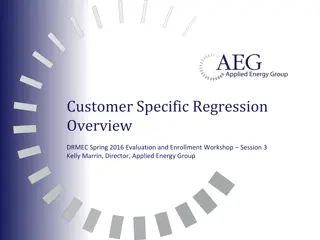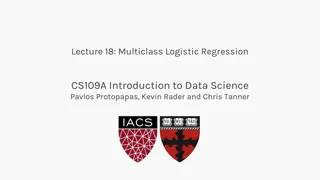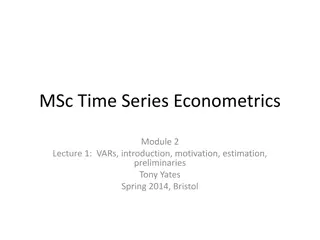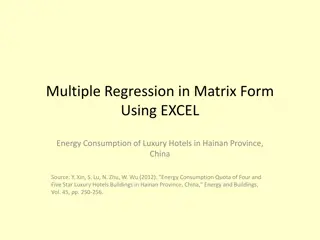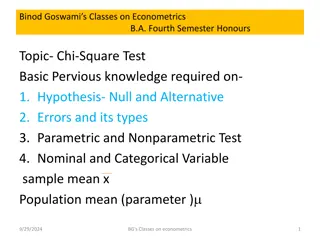Principles of Econometrics: Multiple Regression Model Overview
Explore the key concepts of the Multiple Regression Model, including model specification, parameter estimation, hypothesis testing, and goodness-of-fit measurements. Assumptions and properties of the model are discussed, highlighting the relationship between variables and the econometric model. Various regression planes and error terms are presented to illustrate the application of the model in real-world scenarios.
Download Presentation

Please find below an Image/Link to download the presentation.
The content on the website is provided AS IS for your information and personal use only. It may not be sold, licensed, or shared on other websites without obtaining consent from the author. Download presentation by click this link. If you encounter any issues during the download, it is possible that the publisher has removed the file from their server.
E N D
Presentation Transcript
5.1 Model Specification and Data 5.2 Estimating the Parameters of the Multiple Regression Model 5.3 Sampling Properties of the Least Squares Estimator 5.4 Interval Estimation 5.5 Hypothesis Testing for a Single Coefficient 5.6 Measuring Goodness-of-Fit Principles of Econometrics, 3rd Edition Slide 5-2
= + + S P A (5.1) 1 2 3 2 = the change in monthly sales S ($1000) when the price index P is increased by one unit ($1), and advertising expenditure A is held constant S S P P = = ( held constant) A 3 = the change in monthly sales S ($1000) when advertising expenditure A is increased by one unit ($1000), and the price index P is held constant S S A A = = ( held constant) P Principles of Econometrics, 3rd Edition Slide 5-3
Figure 5.1 The multiple regression plane Principles of Econometrics, 3rd Edition Slide 5-4
= + = + + + ( ) E S S e P A e (5.2) 1 2 3 i i i i i i The introduction of the error term, and assumptions about its probability distribution, turn the economic model into the econometric model in (5.2). Principles of Econometrics, 3rd Edition Slide 5-5
= + + + + + y x x x e (5.3) 1 2 2 3 3 i i i K iK i ( ) x ( ) x E y E y = = k k k other 's held constant x = + + + y x x e (5.4) 1 2 2 3 3 i i i Principles of Econometrics, 3rd Edition Slide 5-6
Assumptions of the Multiple Regression Model = + + + + = , 1, , y x x e i N MR1. 1 2 2 i i K iK i = + + + = ( ) ( ) E e 0 E y x x MR2. 1 2 2 i i K iK i = = 2 var( ) var( ) y e MR3. i i = = MR4. cov( , ) cov( , ) 0 y y e e i j i j MR5. The values of each xtk are not random and are not exact linear functions of the other explanatory variables + + + 2 2 MR6. ~ ( ), ~ (0, ) y N x x e N 1 2 2 i i K iK i Principles of Econometrics, 3rd Edition Slide 5-7
= + + + y x x e (5.4) 1 2 2 3 3 i i i N ( ) ( ) 2 = , , ( ) E y S y 1 2 3 i i = 1 i (5.5) N ( ) 2 = y x x 1 2 2 3 3 i i i = 1 i Principles of Econometrics, 3rd Edition Slide 5-8
Principles of Econometrics, 3rd Edition Slide 5-9
= + + ( ) E y x x 1 2 2 3 3 i i i = + + y b b x b x 1 2 2 3 3 i i i = 118.91 7.908 + 1.863 x x 2 3 i i = 118.91 7.908 + 1.863 S P A (5.6) i i i = 118.91 7.908 + 1.863 SALES PRICE ADVERT Principles of Econometrics, 3rd Edition Slide 5-10
Suppose we are interested in predicting sales revenue for a price of $5.50 and an advertising expenditure of $1,200. This prediction is given by = 118.91 7.908 + 1.863 S PRICE ADVERT = 118.914 7.9079 5.5 1.8626 1.2 + = 77.656 Principles of Econometrics, 3rd Edition Slide 5-11
Remark: Estimated regression models describe the relationship between the economic variables for values similar to those found in the sample data. Extrapolating the results to extreme values is generally not a good idea. Predicting the value of the dependent variable for values of the explanatory variables far from the sample values invites disaster. Principles of Econometrics, 3rd Edition Slide 5-12
= = 2 2 i var( ) ( ) E e e i ( ) = = + + e y y y b b x b x 1 2 2 3 3 i i i i i i N 2 i e (5.7) = 2 = 1 i N K Principles of Econometrics, 3rd Edition Slide 5-13
75 2 i e 1718.943 75 3 = = = 2 = 23.874 1 i N K N = = 2 i e 1718.943 SSE = 1 i = = 23.874 4.8861 Principles of Econometrics, 3rd Edition Slide 5-14
The Gauss-Markov Theorem: For the multiple regression model, if assumptions MR1-MR5 listed at the beginning of the Chapter hold, then the least squares estimators are the Best Linear Unbiased Estimators (BLUE) of the parameters. Principles of Econometrics, 3rd Edition Slide 5-15
The standard errors are = = = se( ) var( ) 40.343 6.352 b b 1 1 = = 1.201 1.096 = se( ) b var( ) b 2 2 = = = se( ) var( ) .4668 .6832 b b 3 3 Principles of Econometrics, 3rd Edition Slide 5-16
= + + + + + y x x x e 1 2 2 3 3 i i i K iK i + + + 2 2 ~ ( ), ~ (0, ) y N x x e N 1 2 2 i i K iK i ( ) b ~ , var b N k k k Principles of Econometrics, 3rd Edition Slide 5-17
b ( ) = = ~ 0,1 , for 1, 2, , z N k K k k (5.11) ( ) b var k b b = = ~ t t k k k k ( ) N K (5.12) se( ) b ( ) b var k k Principles of Econometrics, 3rd Edition Slide 5-18
= ( ) .95 P t t t (5.13) (72) c c b 1.993 = 1.993 .95 P 2 2 (5.14) se( ) b 2 P b 1.993 se( ) + 1.993 se( ) = .95 b b b 2 2 2 2 2 1.993 se( ), + 1.993 se( ) b b b b (5.15) 2 2 2 2 Principles of Econometrics, 3rd Edition Slide 5-19
A 95% interval estimate for 2 based on our sample is given by ( 10.092, 5.724) A 95% interval estimate for 3 based on our sample is given by (1.8626 1.993 .6832, 1.8626 1.993 .6832) + = (.501,3.224) The general expression for a confidence interval is 100(1 [ se( ), k N K b t )% b + se( ) b b t N K (1 /2, ) (1 /2, ) k k k Principles of Econometrics, 3rd Edition Slide 5-20
STEP-BY-STEP PROCEDURE FOR TESTING HYPOTHESES 1. Determine the null and alternative hypotheses. 2. Specify the test statistic and its distribution if the null hypothesis is true. 3. Select and determine the rejection region. 4. Calculate the sample value of the test statistic and, if desired, the p- value. 5. State your conclusion. Principles of Econometrics, 3rd Edition Slide 5-21
= 0: 0 H k H 1: 0 k b = ~ t t k ( ) b N K ( ) se k For a test with level of significance = = and t t t t N K ( /2, N K (1 /2, ) ) c c Principles of Econometrics, 3rd Edition Slide 5-22
Big Andys Burger Barn example = : 0 and : 0 The null and alternative hypotheses are: H H 1. 0 2 1 2 ( ) b The test statistic, if the null hypothesis is true, is = 2. se ~ t b t N K 2 2 ( ) Using a 5% significance level ( =.05), and 72 degrees of freedom, the critical values that lead to a probability of 0.025 in each tail of the distribution are = = 3. 1.993 and 1.993 t t (.975, 72) (.025, 72) Principles of Econometrics, 3rd Edition Slide 5-23
7.908 1.096 The computed value of the t-statistic is = = 4. 7.215 t the p-value in this case can be found as ( 72 P t P t ) ( ) + 2 (2.2 10 = = 10 7.215 7.215 ) .000 ( ) ( ) 72 = Since , we reject and conclude that there is evidence from the data to suggest sales revenue depends on price. Using the p-value to perform the test, we reject because . 0 H .000 .05 7.215 : 0 H 5. 1.993 0 2 Principles of Econometrics, 3rd Edition Slide 5-24
Testing whether sales revenue is related to advertising expenditure = : 0 and : 0 H H 1. 0 3 1 3 ( ) b = se ~ The test statistic, if the null hypothesis is true, is t b t 2. N K 3 3 ( ) Using a 5% significance level, we reject the null hypothesis if 3. . In terms of the p-value, we reject H0if . 1.993 or 1.993 t t p .05 Principles of Econometrics, 3rd Edition Slide 5-25
Testing whether sales revenue is related to advertising expenditure 1.8626 .6832 ) The value of the test statistic is ; ( P t t = = 4. 2.726 ( ) the p-value in given by + 2 .004 = = 2.726 2.726 .008 P t ( ) ( ) 72 72 Because , we reject the null hypothesis; the data support the conjecture that revenue is related to advertising expenditure. Using the p-value we reject . H 2.726 1.993 5. 0 because .008 .05 Principles of Econometrics, 3rd Edition Slide 5-26
Principles of Econometrics, 3rd Edition Slide 5-27
N ( ) 2 y y SSR SST i = = 2 = R 1 i N ( ) 2 y y i = 1 i (5.16) N 2 i e SSE SST = = = 1 1 1 i N ( ) 2 y y i = 1 i Principles of Econometrics, 3rd Edition Slide 5-28
For Big Andys Burger Barn we find that SST = 74 6.48854 = 2 3115.485 SSE = 1718.943 N 2 i e 1718.943 3115.485 = = = 2 = 1 1 .448 R 1 i N ( ) 2 y y i = 1 i Principles of Econometrics, 3rd Edition Slide 5-29
An alternative measure of goodness-of-fit called the adjusted-R2, is usually reported by regression programs and it is computed as /( /( ) SSE SST N N K = 2 1 R 1) Principles of Econometrics, 3rd Edition Slide 5-30
= + = 2 118.9 7.908 (6.35) (1.096) 1.8626 (.6832) .448 SALES PRICE ADVERT R (5.17) (se) From this summary we can read off the estimated effects of changes in the explanatory variables on the dependent variable and we can predict values of the dependent variable for given values of the explanatory variables. For the construction of an interval estimate we need the least squares estimate, its standard error, and a critical value from the t-distribution. Principles of Econometrics, 3rd Edition Slide 5-31
